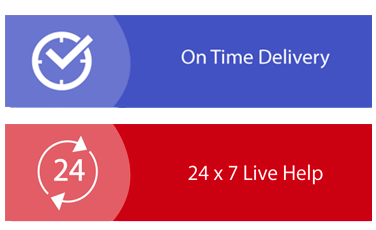PSYC20042 Building Wellbeing and Resilience Assignment Sample
Question
In Assessment descriptive essay help online, you are required to collect and evaluate a series of resources pertaining to wellbeing in different areas.
For Assessment 1, You will:
1. Choose five topics from a list of wellbeing topics (please see below). You are also required to include an additional (sixth) topic area of Aboriginal and Torres Strait Islander peoples and wellbeing.
2. Pertaining to the six topics (five chosen topics from the list and one of Aboriginal and Torres Strait Islander peoples and wellbeing), source and collate a collection of peer-reviewed research articles, quality relevant websites, research-oriented summary media articles, and videos.
3. Reference each resource using APA style 7th edition.
4. For the six topic areas, summarise, analyse, and evaluate the collected resources (400 words +/- 10% per topic area).
Topic areas
1. Exercise and wellbeing
2. Nutrition and wellbeing
3. Mind-body wellness
4. Positive Education
5. Ageing and wellbeing
6. Families and wellbeing
7. Eco-psychology
8. Animals and wellness/animal therapy for humans
9. Building social support/social connections
10. Play/fun/recreation
11. Spirituality, meaning, and purpose
12. Stress reduction for wellbeing and resilience
13. Complementary and alternative medicine
14. Building wellbeing, resilience, and coping skills
15. Enhancing creativity
16. Sleep and wellbeing
17. Parenting and wellbeing
18. Work and wellbeing
19. The built environment and wellbeing
20. Creative arts and wellbeing
21. The benefits of social support
22. Effects of green space on wellbeing
23. Meditation and/or mindfulness
24. Intellectual development (can include curiosity)
25. Physical therapies and practices known to enhance wellbeing
26. Particular practices (e.g., gratitude, self-compassion, savouring)
27. Other. If you wish to research a related topic(s) not listed above, please contact your Unit Coordinator regarding the suitability of the topic.
Compulsory Topic: Aboriginal and Torres Strait Islander Peoples and Wellbeing.
Sourcing and Collating Resources
It is expected that for each topic area, students collect a minimum of 4 resources. This means that you will have a minimum of 24 references for your assessment piece.
All collected resources (e.g., websites, videos) should be underpinned by peer- reviewed research. For each of the topics, the resources should include at least one review article (e.g., systematic review, narrative review) from a peer-reviewed journal. Other resources may include peer-reviewed research articles describing studies undertaken, quality relevant websites (e.g., material from Psychology Today or Scientific American), research-oriented summary media articles, and videos (e.g., TED Talks, videos posted to YouTube by experts in the area).
Topic area resources collected must have a primary focus on positive psychology and/or wellbeing and resilience.
For each topic area, your chosen resources should cover psychological, physiological/physical, and environmental approaches to wellbeing/resilience.
Each topic area must include at least one resource pertaining to a wellbeing intervention/exercise/practice pertaining to the topic area.
An Example
If you were to choose self-compassion and wellbeing as a topic, you would want to collect:
• One peer-reviewed review article, such as a review article that has explored the impact of self-compassion on some aspect of wellbeing.
You would also want to ensure that the resources you collect include material describing:
• Psychological aspects of self-compassion – for example, what are the benefits of self-compassion for wellbeing, such as happiness or better relationships
• Physiological/physical aspects – such as what happens to the body when a person experiences compassion
• Environmental aspects. For the last aspect, you might have to think carefully about this. There is probably not going to be research on self-compassion and nature/green space, for example. But perhaps you can look at sourcing an article that examines self-compassion in a particular context, such as the nursing environment where it is suggested that the nature of the work/environment means that they may benefit from building their self- compassion skills.
Summarising and Evaluating Resources
For all six of your topic areas, examine in 400 (+/- 10%) words per topic area:
• What the collected research can tell us about the wellbeing area. That is, analyse what the collected resources tell us about wellbeing and the topic area.
For example, if the topic was sleep, what do the resources tell us about the effects of sleep (e.g., sufficient sleep, lack of sleep) on our wellbeing? This is an overall or global summary of what your resources tells us.
• The links between psychological, physiological, and environmental approaches to understanding wellbeing and/or resilience in the topic area. For example, if the topic was sleep, what do the resources tell us about sleep from a physiological (e.g., how does sleep affect us physiologically?), a psychological
(e.g., how does sleep affect us psychologically?), and from an environmental
(e.g., what aspects of the environment affect our sleep?) perspective.
• The wellbeing intervention or practice, including the reasons it was chosen and its evidence base. For example, what is an intervention to improve sleep and is their evidence for its effectiveness?
• What are the strengths, weaknesses, and gaps in the literature? – that is, evaluating the resources (please see below).
Evaluating Resources
An important part of this task is to provide some critique of the resources, such as gaps or unanswered questions posed by the research; methodological strengths and weaknesses of the collected materials; and what we may need to consider when using the intervention collected.
That is, while describing what the research tells us about wellbeing and the links between psychological, physical, and environmental approaches is a part of your write-up, you will engage in critical analysis and evaluation of the resources in order to make broader conclusions about what the collected resources can tell us about the topic area.
Some of the things that you might want to consider when evaluating resources are included below. Since you have a limit of 400 words per topic, you would only want to discuss 2 or 3 of these things. You can also choose whether you discuss these things at the end of each of your write-ups, or whether you integrate the evaluation throughout your write-up.
Please also remember that you are critiquing from the perspective of the resources that you have collated on that topic area. For example, you do not need to do an exhaustive literature search to see what groups have not been investigated, or to find what questions have not been answered. What we are looking for in your critique is evidence that, based on what you have collected, you have thought logically about the resources. For example, if most of what you have collected involved younger people, you might want to suggest why some research should be conducted with older people (this may or may not have been done – you do not need to go find out).
Potential Evaluation Areas:
• What groups have not been investigated/could be investigated regarding the topic?
For example, have younger but not older people been investigated; are most of the resources focused on the Western world?
• What relationships have not been investigated?
For example, has the effect of a practice on hedonic wellbeing been investigated, but not eudaimonic wellbeing?
• What outcomes are we not aware of?
For example, did the resources collected focus on one outcome of an intervention
(e.g., better relationships) but not others (e.g., better physical health).
• Is the method of investigation used (e.g., survey, experiment) the most appropriate one for the topic?
For example, what might be the problems with a self-report survey?
• What types of measures have been used in the resources collected? Are they appropriate?
For example, were measures considered valid or reliable.
• Has the research been done with enough people?
For example, was the sample relatively large (e.g., 100 people) or much smaller (e.g., 10 people). Remember, generally quantitative studies will have larger samples than qualitative studies.
• Does the sample of participants accurately reflect the characteristics of the population of individuals about which the researchers are trying to draw conclusions – that is, is the cohort used generalisable to the broader population?
For example, did the researchers want to investigate self-compassion in nurses, but only collected data on one type of nurse (e.g., mental health nurse). Does that mean we can make conclusions about mental health nurses, but not other (e.g., surgical) nurses?
• What questions have not been answered?
For example, did the researchers focus on exercise practices indoors, but not out in nature?
• Are there conflicting results between studies?
For example, do some of your resources suggest that the topic area impacts physiological wellbeing, while others don’t? Do we need to do more studies to resolve this?
For the intervention, specifically, some of the things to consider include:
• What is the evidence for the intervention chosen? Does the evidence support the efficacy of the intervention to improve wellbeing?
For example, is there good evidence that a self-compassion exercise can improve wellbeing?
• In what types of settings, people (populations), and method of delivery has the intervention been found to work best?
For example, is the evidence for the efficacy of the intervention stronger for younger versus older people; or have most studies investigated efficacy with one type of group.
• Are there particular gaps in our knowledge?
For example, have particular groups not been investigated?
Solution
1. Positive Education
In order to adopt positive mental health and different kinds of positive functions, the momentum corresponding to the positive psychology movement has to be increased.. Along with that, different principles of positive psychology are combined through the positive education, blended with best teaching practices (TED and mendro Foundation, 2021). Moreover, through positive education, a good link is created between academic success and well-being (PESA, 2022). In such circumstances, the framework of positive education is developing the Australian schools. Various well-being domains are positive engagement, positive emotions, positive purpose, positive health, positive relationships and others. Besides, a structured process is implemented through positive education where a better evaluation and research are guided by this education layout for mental health development (White & Kern, 2018). On the other hand, feeling good and doing good are indicated by the flourishing where different types of character strengths are included.
“Martin Seligman's PERMA model” and the “Values in Action (VIA) classification” can be implemented in the programs and interventions for well-being and happiness corresponding to positive education. Besides, in the positive education programs, the PROSPER framework can be utilized which indicates the integration of multiple principles corresponding to positive psychology along with effective teaching and learning process for good outcome.
Joy, hope, gratitude is involved with the positive emotions which have to be developed through the positive education for mental happiness. Moreover, the concept of happiness, different motivation, hopes, self-esteem and empathy are aimed by the positive education where several activities can be performed like tree plantation, pollution free nature and others for mental health development. In such correspondence, psychology, physiology and environment are connected well being through the positive education.
Besides, interest, absorption and engagement are included in the positive engagement whereas the positive accomplishment included the achievement of the meaningful outcomes (Seligman & Adler, 2018). Along with that, physical and psychological health is improved by positive health. In such correspondence, for the implementation of the positive education, several positive domains have to be lived, taught and enabled. In such correspondence, the tent of positive education is lived by the well-being support staff (Halliday et al., 2019).
Less social activities and poor maintenance of mental health, less contribution from the parents can be harmful for a child that can be considered as the weakness of positive education and wellbeing. Furthermore, various traditional skills are taught through this process where it is enabled in the school community for the implementation of positive education. In such accordance, in the schools, positive education has to be implemented for the development of mental health and different positive aspects blended with the well-being of the society.
Reference
Halliday, A. J., Kern, M. L., Garrett, D. K., & Turnbull, D. A. (2019). The student voice in well-being: A case study of participatory action research in positive education. Educational Action Research, 27(2), 173-196.https://www.tandfonline.com/doi/pdf/10.1080/09650792.2018.1436079
PESA, (2022).Personal Development opportunities.Retrieved fromhttps://www.pesa.edu.au/. [Retrieved on 25 March 2022]
Seligman, M. E. P., & Adler, A. (2018).Positive education.Global happiness policy report, 52-73.https://www.researchgate.net/profile/Alejandro-Adler/publication/331936613_Positive_Education_Seligman_M_E_P_Adler_A_2019_Positive_Education_In_J_F_Helliwell_R_Layard_J_Sachs_Eds_Global_Happiness_and_Wellbeing_Policy_Report_2019_Pp_52_-_71_Global_Council_for_Wellbeing_and_Ha/links/5c93baca92851cf0ae8e98bf/Positive-Education-Seligman-M-E-P-Adler-A-2019-Positive-Education-In-J-F-Helliwell-R-Layard-J-Sachs-Eds-Global-Happiness-and-Wellbeing-Policy-Report-2019-Pp-52-71-Global-Council-for-Wellbein.pdf
TED and mendro Foundation, (2021). How every child can thrive by five.Retrieved from https://www.ted.com/talks/molly_wright_how_every_child_can_thrive_by_five?language=en. [Retrieved on 25 March 2022]
White, M., & Kern, M. (2018). Positive education: Learning and teaching for wellbeing and academic mastery.https://hekyll.services.adelaide.edu.au/dspace/bitstream/2440/118534/3/hdl_118534.pdf
LC3002 English For Academic Purpose Resit Information Assignment Sample
Assignment Brief
ESSAY TASK:
You are answering the same essay question that you did last term:
• You will produce a problem / solution essay of 1500 words +/- 10%, focusing on either the problems associated with gender inequality or global migration, and some suggested solutions to those problems. You will be expected to use sourced material to support your essay and to demonstrate your ability to provide references and a bibliography.
• You must not copy text from the internet or books. You risk failing if you do this.
• You must include references and a bibliography. (Remember you have free access to Cite them right online - Home when you log in using your UEL email.)
• If you submitted an essay last term but you didn’t get a score of 40, you need to improve the essay before you resubmit it. Check your grammar and vocabulary and make sure you haven’t copied from the internet.
Include references for assignment help
ESSAY HAND IN DATE:
Essay: 15:00 Friday 19th March via the module from last term on Moodle: Course: LC3002 2021 (T1)
English for Academic Purposes (OC) (uel.ac.uk) Then go to “Assessment” and “Essay Resit”.
Solution
GENDER INEQUALITY
Introduction
Gender is a key indicator of socioeconomic division, and therefore, of exclusion. There are significant differences between men and women in material well-being, irrespective of social status through the level of disparity that exists across sectors and regions. As a consequence, most communities have gender disparities, with males traditionally occupying higher roles in social, financial, and political structures. The aim of eliminating gender disparity has occupied a central position in international organizations and national policy proposals for more than twenty years. Millennium Development Goal 3 represents the worldwide attention to the problem of gender discrimination and has provided policymakers with the incentive to eradicate it. Gender difference is not solely propagated by unequal access to and ownership of economic resources. Also, men and women are treated differently in the same workplace, given different wages for the equal amount of work done by them. As a whole, gender roles and expectations promote gendered identities and regulate women and men's actions in ways that contribute to discrimination (Ridgeway, 2011).
Three domains of gender inequality
The following principles serve as the foundation for this framework for analyzing global developments in inequality. Gender equity in the first domain is based on skill equality, which ensures that males and females are on an equal level in terms of core functions (schooling, healthcare, and nutrition). Furthermore, in order to enhance financial equality, women must be able to turn their talents into the ability to produce income on par with men, implying that advances toward gender parity in socioeconomic well-being must be made. Although people neglect gender-disaggregated statistics on wages, data on gender differences in access to employment, credit, and land ownership rights should enable us to assess fairness in this second domain. The final component, service, is concerned with decision-making autonomy and representation in society's key resource distribution sites: the home, the office, and regulatory bodies. Women can be capable of influencing the conditions that contribute to inequalities in the skills or lifestyles domain if they have a voice in these fields. As a result, these 3 domains are interconnected (Huang et al., 2020). The shift in a single domain can be leveraged by progress in another. Furthermore, advancement in any one of these three domains is insufficient to accomplish the ultimate objective of equality of the sexes without development in the others.
Gender-based abuse
Aggressive behavior is widely accepted as a natural part of the behavior of men and a necessary part of becoming a man. In reality, violence is culturally 'masculinized.' Gender-based abuse is linked to power structures and emotions – the exploitation of women and some male groups. Gender disparity leads to the perpetuation of a violent society. Men are less hesitant to use and degrade women because of their own purposes since the wellbeing of men is considered to be of greater significance. Women are treated as anything less, as individuals entitled to male authority. Despite the fact that the strict concept of gender includes male, female, as well as other gender identities, most individuals still perceive gender discrimination issues as women’s concerns. Gender disparity, on the other hand, affects all, even men. Stereotypes or 'regulations' on how men, women, girls, and boys must behave begin in early childhood and continue throughout adulthood. Inequality does not affect everybody in an exact way. Those who are exposed to various types of prejudices face a more complicated situation, which is often more harmful.
Inequalities in wage distribution
Men and women employees earn different salaries for jobs of equal importance, which is one of the fields at work where gender disparities can be seen (Heymann et al., 2019). According to a 2013 report by the International Labor Organization, the international wage disparity is 23%. However, this figure excludes the women around the world who operate in the unregulated informal economy with no legal security. Furthermore, many nations lack reliable data to produce more detailed reports, resulting in an even higher percentage of disparity. Due to these participants and demographic implications, gender wage disparities decrease female jobs, which raise fertility and reduce economic growth. As a result, exposure to and power over properties, and lifelong social security protection is also inadequate.
Inequalities in education system
Access to higher education remains critical to closing the pay disparity. It is not, however, the only measure, since highly educated women are at the extremes of the gender divide. Unequal and uneducated communities have a lower degree of harmony. They are more likely to engage in anti-social activity and aggression. Inadequate access to education is expressed in the daily struggles of women's and girls' affairs, such as the growing number of women living below the poverty line compared to males, women's and girls' deprivation of autonomy over their identities, and abuses of sexual and reproductive freedoms, and disparities in job opportunities.
Argument on the problems
Gender equality strengthens ties between nations. Their citizens are in healthy condition and have a greater sense of well-being. For far too long, women have attempted to address these issues on their own: by balancing work and home life, undergoing further training, and struggling to smash through the power structure. However, it has become particularly important for people of all genders to work together to address the issues of gender equality. A sociological viewpoint indicates a variety of steps to resolve the behavioral and structural variables that lead to gender inequality. It is important to reduce the socialization of girls and boys into stereotypical gender norms by parents and other family members (Tay et al., 2018).
The consequences
Inequalities in the participation in economic and social benefits, such as fair jobs and wage equality, Gender disparity results in a significant loss of human resources, with consequences for both men and women. Social justice is thus central to democracy, progress, and a human rights framework in which everybody has a share (Heise et al., 2019).
Probable solutions to the problems discussed in three domains
In general, the number of men who earn is much higher than that of women. Increasing mentorship and other attempts to raise the percentage of women in predominantly male professions and political leadership roles would inculcate trust and integrity in them. Many government initiatives, such as increased monetary assistance for child care, can also contribute to having female workers who want to preach their passion.
Due to the wage-gap issues, UNI has committed to working to ensure that ILO Convention 100, which mandates fair pay for equal work, is implemented in every workplace. On the one side, Cavalcanti and Tavares' research indicates that wide wage disparities between men and women would impede economic development. Boosting government funding for elevated day-care alternatives is vital to enable families, especially mothers, to operate outside the house if they wish, without fear of jeopardizing their wealth or their kids’ well-being.
The biggest thing that can contribute to more advancement in society and let women have their say in various matters is a shift in people's attitudes. With the help of digital platforms like Facebook, Twitter, and news media, people of both genders must address gender discrimination.
There ought to be a greater public awareness of the causes for physical and sexual harassment, as well as the scope and repercussions of sexual harassment and exploitation. The effective implementation of current legislation prohibiting gender-based disparities in the workplace and sexual assault in the workplace will help to alleviate workplace gender inequality. Funding for support centers and other programs for males and females who have also been sexually abused should be increased. It is important to remember that everyone, regardless of gender, maybe assaulted and harassed. Abuse, sexual harassment, and domestic violence can decline as gender disparity decreases (Cerrato & Cifre, 2018).
Unequal expenditures in girls' schooling at the household stage, for instance, can be corrected by ensuring that government funds are provided to enhance girls' access to quality education.
Courageous women and men questioned the power structure by bringing harassment and sexual abuse, and domestic abuse into the public conscience, and by drawing attention to gender disparity in the office, school, and elsewhere. In order to continue to minimize gender inequality, a successful women's movement must continually remind us of the patriarchy that still exists in various cultures and around the world. Only by resolving the overwhelming burden of suffering, lack of accessibility to knowledge and health care, and shortage of productive opportunities faced by women will inequality be eradicated.
Conclusion
Inequality between men and women occurs in most cultures around the globe in varying degrees. Despite the fact, due to the modern women's rights movement, these disparities have diminished significantly since the early 1980s. They still exist and obstruct attempts to achieve complete gender equality. Gender discrimination is caused by a complex combination of cultural and social influences, according to sociologists, which must be resolved if gender inequality is to be minimized more than it has been since the early 1980s. Despite the changes that occurred during this era, children are still socialized from birth to conventional conceptions of male and female roles, and gender-related stereotyping centered on these notions persists (Dashper, 2019). Regardless of the fact that people should be able to follow whatever family and job commitments they choose, socialization and stereotyping continue to hinder the willingness of girls and boys, males and females, to consider less conventional options.
References
Ridgeway, C. L. (2011). Framed by gender: How gender inequality persists in the modern world. Oxford University Press.
Huang, J., Gates, A. J., Sinatra, R., & Barabási, A. L. (2020). Historical comparison of gender inequality in scientific careers across countries and disciplines. Proceedings of the National Academy of Sciences, 117(9), 4609-4616.
Heise, L., Greene, M. E., Opper, N., Stavropoulou, M., Harper, C., Nascimento, M., ... & Gupta, G. R. (2019). Gender inequality and restrictive gender norms: framing the challenges to health. The Lancet, 393(10189), 2440-2454.
Heymann, J., Levy, J. K., Bose, B., Ríos-Salas, V., Mekonen, Y., Swaminathan, H., ... & Gupta, G. R. (2019). Improving health with programmatic, legal, and policy approaches to reduce gender inequality and change restrictive gender norms. The Lancet, 393(10190), 2522-2534.
Batz-Barbarich, C., Tay, L., Kuykendall, L., & Cheung, H. K. (2018). A meta-analysis of gender differences in subjective well-being: estimating effect sizes and associations with gender inequality. Psychological science, 29(9), 1491-1503.
Cerrato, J., & Cifre, E. (2018). Gender inequality in household chores and work-family conflict. Frontiers in psychology, 9, 1330.
Dashper, K. (2019). Challenging the gendered rhetoric of success? The limitations of women?only mentoring for tackling gender inequality in the workplace. Gender, Work & Organization, 26(4), 541-557.
EAP2 English for Academic Purpose Assignment Sample
Assignment Brief
In order to meet the requirements for Academic Purposes 2, all students must write a Cause and Effect essay citing reasons from various sources for assignment help.
Cause and Effect Essay
Question: Discuss the effects of on society.
Possible Cause Examples:
• 3d printing (design, IT and business students)
• Antibiotics (health students)
• Preservatives/food additives (catering and hospitality students)
• Block chain technology (IT and business students)
• Negative gearing (accounting and business students)
• Zoning/lock out laws (hospitality students)
• Plastic (fashion, business, health students) Write a cause and effect essay based on at least 6 references (2 journal articles, 2 industry sources and 2 government sources)
Learning Outcomes:
• Can analyse and synthesize information
• Can identify relationships and/or patterns
• Can show understanding of the literature and evidence of critical evaluation
• Can provide an appropriate conclusion
In order to successfully complete this assignment, follow the steps listed below:
• Write 6 paragraphs: introduction, 2 cause paragraph, 2 effect paragraphs, conclusion, reference list (separate page)
• Read references to find evidence to support your 2 cause paragraphs and/or your 2 effect paragraphs
• See that you have explained the main reasons for the causes (e.g. why was there a need for antibiotics or plastic)
• See that you have explained the main effects of these causes (e.g. an environmental effect such as pollution from plastic or a health effect from food additives)
A well-structured Cause and Effect essay must include:
• A cover page clearly stating your name, student ID, title of the essay, your teacher's name and word count
• An appropriate introduction
• A critical analysis in 2 cause paragraphs and 2 effects paragraphs
• An appropriate conclusion in which you summarize the main points
• A reference list following the APA Gh referencing conventions
Solution
Introduction
Plastic materials are diverse products and bi-products of petrochemicals. Global plastic production has increased exponentially in the past decade. Disposability feature along with the low rate of recycling of plastics considerably increase waste production internationally. For example in Australia in between the years, 2010 and 2011 plastic waste produced was around 1,433,046 tonnes. Around 20% of t his amount was only recycled. National plastic production rate production in the year 2017-2018 was 9.4 percent (Environment.gov.au, 2018). The country’s government acknowledges the threat caused by plastic to the marine ecosystem. To combat this better understanding of the hazards of plastic waste to marine life in Australia is made through this paper.
Cause
The advantages of plastic cannot be denied. Plastic material is lightweight, easy, and cheap and this has led to the huge production and use of plastic in the world. Such a trend will continue increasing in the next decade as well. The resulting environmental degradation needs the government of Australia to understand, regulation and innovate ways to optimize the waste creation and disposal of plastic for conservation of life. Plastics as bi-products are increasingly used for the vulnerable item packaging and containerization of manufactured products due to their durability and cost effectiveness. Gradually they have become a unique commodity in their genre (Comanita, Hlihor & Ghinea, 2018). The versatility of plastic has become an increasing trend all over the world. Unfortunately, a large mass of such plastics are disposed of in the environment. The vulnerable products which go through transit and transportation need to be protected from contamination. Moisture, microorganisms, humidity, insects, gases, and lights are such external and internal contaminants that can damage such products and impact their quality. As a result, its value will be degraded (Ritchie & Roser, 2021). Plastics are used for such vulnerable products for effectively safeguarding their quality and integrity.
The main reason for using plastic packaging is to protect food from getting spoilt. The food waste in the world is extremely high. This leads to a very high environmental impact since a massive carbon footprint is caused due to the waste created from packaging with plastic. There was an acute need for using the plastic package as using this food can travel too long distances, stay on the shelves for long and large wastage of food could be avoided. A large amount of resources is used all over the world for creating food. It is natural to take steps to maintain its quality as long as it is possible (MarketResearch, 2021). Moreover, countries located in all parts of the world can get a supply of food products such as powders, spices, and liquids which are even out of season owing to special plastic protection added to them.
Effect
Plastic debris is a continuous problem in the oceans of the world. Government worldwide is recognizing the need to manage such issues. Marine debris is the consistent, processed, and manufactured solid discarded materials which are abandoned or disposed of in the coastal and marine environment (Asuquo, 2018). The bio-diverse life in the marine ecosystem comprises of species which are to be protected. The debris causes threat to their life system. Injury, death via drowning, entanglement caused by internal injuries, starvation and ingestion are the major impacts created by plastic waste and debris in the water bodies in this nation. The marine mammals, turtles, and sea birds severely get injured sometimes and even die from the entanglement of such marine debris. This can limit their mobility, cause infection, starvation, drowning, amputation, and smothering. The sea birds at times become entangled in the fishing lines. Such fishing lines and nets have plastic-packed straps. Often marine debris is lost from them when the nets are used fast in the water. When consumed marine mammals can lose their fastness in movement in the water, ability to hunt prey as well as safeguard themselves from predators. This can lead to obstructions in blood circulation and sometimes leads to asphyxiation as well as death. The skin of the turtles and marine mammals is also impacted if cut through the plastic of ropes and nets in fishing lines. This can lead to infection and also sometimes causes amputation of the tail, flippers, or flukes.
Research has suggested that around 90% of marine birds in the last two decades have consumed some kind of plastic material in their lifetime. It can puncture the internal organs as it moves through the alimentary canal. At some time the plastic debris can remain in the intestine and stomach as well. Migratory birds, as well as their young nestlings, are also at high risks of death as they ingest the plastic which leads to a full feeling in their stomach. This is a misleading feeling since it is not food and hence they attempt early migration. The nutritional value of the consumed plastics runs out soon from the body of these birds. Their energy degrees and they drop down lifeless as they do not have food to sustain themselves for reaching their destination (Gbrmpa.gov.au, 2021). The birds which are young feed from parents attempt to get the nutritional value from plastic but do not get adequate energy and nutrition. Such young birds die early and do not even reach adulthood. This leads to the less addition of adult population in such birds. Sensitive species can even go extinct in this manner as the food web is directly impacted due to their total dependence on marine environment.
Conclusion
There are varied kinds of plastics and their chemical composition is also different. Some plastics are used for protection or wrapping, food packaging, or used as fishing nets and lines and biodegradable items. Although some plastics are recyclable yet the remaining can cause a disastrous impact on marine life. The massive production of such plastic products, their toxic impacts, entanglement, strangulation, starvation, malnutrition, and micro plastic impacts on Australian marine life is life-threatening. The government of Australia has developed varied environmental acts and policies for optimizing production, use, and disposal of waste from plastic materials to conserve marine life and the environment.
References
Asuquo, I. (2018). Plastic Waste in the Aquatic Environment: Impacts and Management. Environment, 2(1), 1. https://doi.org/10.31058/j.envi.2018.21001
Comanita, E., Hlihor, R., & Ghinea, C. (2018). Occurrence Of Plastic Waste In The Environment: Ecological And Health Risks. Environmental Engineering And Management Journal, 15(3), 675-685. https://doi.org/10.30638/eemj.2016.073
Environment.gov.au. (2018). Department of Agriculture, Water and the Environment. Department of Agriculture, Water and the Environment. Retrieved 26 March 2021, from https://www.environment.gov.au/protection/waste/publications/australian-plastics-recycling-survey-report-2017-18.
Gbrmpa.gov.au. (2021). Marine debris. Retrieved 26 March 2021, from https://www.gbrmpa.gov.au/our-work/threats-to-the-reef/marine-debris.
MarketResearch. (2021). Australia Plastic Market Research Reports & Analysis page 1. Marketresearch.com. Retrieved 26 March 2021, from https://www.marketresearch.com/seek/Plastic-Australia/1606/1358/1.html.
Ritchie, H., & Roser, M. (2021). Plastic Pollution. Our World in Data. Retrieved 26 March 2021, from https://ourworldindata.org/plastic-pollution.
ECL101 Language and Print Literacy Development Assignment Sample
This is an individual essay in which you will discuss the typical patterns of child development in language and early print literacy. To complete this task, you will draw on the teaching materials and essential readings for modules one-four. The recommended readings will be a helpful resource to support students who are aiming for a high mark. We discourage the use of outside resources as these are not necessarily reliable.
You will:
a. define oral language, phonological and phonemic awareness, grapho-phonic decoding, and language comprehension
b. discuss key stages in the development of each of these skills. Please discuss at least three and no more than five stages for each skill. You may condense stages or choose up to five distinct ones. It is particularly important that you are selective with your oral language and language comprehension stages.
c. highlight how each of these skills contributes to students’ print literacy development in the early years of schooling.
Your essay will include a brief introduction and conclusion. Use either Deakin Harvard or APA referencing style to show the sources of your ideas.
Solution
In the last two decades, phonemic awareness and phoneme recognition have been identified as important factors in determining literacy development (Kardaleska & Karovska-Ristovska, 2018). The study by Bradley & Bryant (1978) found evidence pointing toward the opposite conclusion regarding the relationship between early reading and phoneme awareness. They compare two sets of people for a phoneme awareness test during their study. The first group was a group of older disabled readers to a younger group of typically reading readers who were matched by reading level with them. It was not possible to attribute the differences in learning between typical readers and the disabled to differences in orthographic knowledge because of how the study was designed (Bradley & Bryant, 1978).
One task involved detecting rhyme and alliteration by each group of young people, while the other required them to come up with their rhymes. Both of these tasks for assignment help were performed significantly worse by older disabled readers than by younger matched readers. According to Bradley and Bryant, both groups were reading at the same level of proficiency, even though Morais (1987) concluded that reading promotes phonemic awareness (Morais, 1987).
From the various test on the phoneme awareness test on the children, it was found that the conclusion that phoneme awareness tasks can teach children to recognize or write words they were never exposed to before (Ball & Blachman, 1991). Once children realize that speech can be segmented into different bits and that these segments are represented by letters, they seem to be able to understand and use sound-symbol relationships much more easily (Blachman, 1991).
.png)
(Note - The difference between Phonological Awareness and Phonemic Awareness by Christina, 2022)
Phonemic awareness has many components it includes identifying and manipulating parts of the oral language, including rimes, onsets, syllables and words. In addition to identifying and making musical rhymes, children who have phonological awareness can recognize words with similar-sounding beginnings, such as 'mother' and money' and in addition to this, they can also clap the number of syllables in a word.
Phonemic awareness refers to the skill of manipulating and focusing on individual sounds in spoken words. These smaller units make up spoken language. Syllables and words are composed of phonemes. For instance, the word 'mat' has three phonemes: /m/ /a/ /t/. Languages such as English have 44 phonemes, including combinations of letters such as /th/. A sound understanding of phonemic awareness is necessary for recognizing words and spelling well. Children's level of phonemic awareness during their first two years of school is one of the best indicators of their ability to learn to read. Phonological awareness and phonemic awareness are lower among students at risk for reading difficulties.
When it comes to students' phonological awareness, there is a continuum of progressively acquired skills. These skills are essential to a student's success in developing reading and spelling skills, as they are fundamental to being able to decode and spell written words. When children are developing their reading skills, phonological awareness is especially crucial in first grade, kindergarten and pre-school. Some students can eliminate reading problems in the future with the explicit teaching of phonological awareness during these early years. It is possible to enhance phonological awareness in struggling decoders at any age, especially in those who have difficulties in segmenting or blending phonemes.
There are five different levels according to which progress in phonemic awareness can be measured. They are discussed in this paragraph. Phoneme segmentation; the phoneme segments often deal with the segmentation of the phenome. The phenome segmentation can include the segmentation of syllables. The first segment is the sentence, then the second is the word, and finally, the third segment is the sentence; when all this segment comes together, they add meaning to the sentence. An understanding of the sound of a word involves counting and recognizing the phonemes individually. It means different things when one moves from word segments to sentence segments as phonemic awareness involves identifying the sounds of various parts of sentences, letters, and words. Learners are internalizing how each letter sounds differently when they attempt to grasp syllable segmentation. The ability to pronounce a word properly requires knowledge of which parts of the mouth are used. In addition, it can improve reading comprehension and improve word recognition (Müller et al., 2020).
The next is phoneme blending and splitting, in this expression, phonemes are blended and separated to form new words. The correct blending is required when the student has learned the sound of each phoneme. The process of onset-riming is a process by which the phonemes are split and merged in the mind to determine the end (riming) and the beginning (onset) (Singh, 2020). It is a pretext to teach spelling through phonetic splitting and blending when teachers ask students to speak.
The third is phoneme alliteration and rhyming, phoneme alliteration and rhyming involve words that sound alike to one another. Alliteration takes advantage of words that have the same sound at the beginning of the sentence, while rhyming uses the commonality of ending sounds (Singh, 2020). Learning tongue twisters is part of alliteration practice. Alliteration can be seen in phrases such as “she sells seashells at the beach”. The repetition of the same sound, over and over, acquaints the child with various sounds. Lastly, phoneme contrasting and comparing. It involves changing the sound of a word by using contrasting phonemes that change its meaning. The contrasting phonemes are f and v since they sound out differently due to the application of the phonetic difference. Furthermore, the meaning of these sounds is altered when they are replaced. The words Fan and Van may rhyme, but their differing phonetic meanings place them in separate phoneme categories. Finally, phoneme manipulation and writing. The goal of phonological manipulation is to manipulate or change individual phonemes while keeping in mind the specific roles each phoneme plays in each word. The act of reading is composed of several steps. Cognitively, students rearrange, replace, or alter sounds to arrive at the correct pronunciation. Students who can read connected texts successfully must be able to do this (Singh, 2020).
Teaching the student is a difficult job when it comes to phonological awareness. There are a few ways in which phonological awareness can be developed in children. These techniques are developed by different researchers. The first is by giving multisensory instruction ("How to Teach Phonological Awareness using a Research-Based Approach | SMARTER Intervention", 2021). The phonological awareness of many struggling writers and readers is particularly problematic. Providing these students with visual and tactile aids to show the way words are broken down is one of the best ways to help since many of them have difficulty processing the sounds. Students may be able to make this connection by using visual aids, placing their hands under their chin to feel the vowel sound drop, and using motor cues. Below are the many tips starting from visual, auditory, using different colours, and lastly kinesthetic tips.
.png)
(Note- Various styles for multisensory instruction by "How to Teach Phonological Awareness using a Research-Based Approach | SMARTER Intervention", 2021)
The above-mentioned various tips will help in teaching the small children about phoneme recognition and it will also raise phonemic awareness.
The next teaching style that helps teach phonological awareness is by focusing on every single phoneme. In the beginning, the biggest mistake was not understanding that phonological awareness activities could help with reading and writing. No letter knowledge or letter-sound pairings are needed for phonological awareness, it is simply sound understanding. Phonics-based instruction would be achieved by combining sounds with letters through phonological awareness instruction. Students could be shown the syllable pattern and the letter pattern as the teacher helps them understand how multi-syllabic words fit together as they read them. Alternatively, break out words into individual sounds (r-controlled sounds, vowel sounds, and consonant sounds) as everyone hears them.
.png)
(Note - breaking words into individual sounds by "How to Teach Phonological Awareness using a Research-Based Approach | SMARTER Intervention", 2021)
A Phonological Awareness Diagnostic Assessment can help teachers determine the level of phonological awareness students have ("Phonological awareness diagnostic assessment", 2021). Assessing student progress in developing foundational literacy skills complements existing strategies. By doing so, students have the opportunity to show what they can do and what they know, which in turn provides teachers with information about their students' skill levels. By selecting which subskills to assess, teachers can use the assessment for individual students, depending on their needs. Students are assessed by classroom teachers individually and the assessment takes 10-12 minutes ("Phonological awareness diagnostic assessment", 2021). The student assessment will be categorised into many sub-sections phoneme segmenting, phoneme blending, syllable segmentation, syllable blending, sound isolation, rhyming, auditory discrimination, and sentence segmentation ("How to Teach Phonological Awareness using a Research-Based Approach | SMARTER Intervention", 2021). Responses to the assessment are entered into the online tool by teachers for better analysis. This record will be checked to monitor the progress of the student.
.png)
(Note – Example of student assessment in Phonological awareness by "How to Teach Phonological Awareness using a Research-Based Approach | SMARTER Intervention", 2021)
A child's mind can be moulded to learn about phonological awareness, either through multisensory instruction or by breaking every phoneme down individually. It will be beneficial when using these two methods for teaching since they build a deeper understanding of the English language. In this teaching methodology, every single bit of phonological awareness will be highlighted by the teacher as part of the assessment, and the student will be able to learn the language quickly.
References
.png)
EDUC1001 Language and Learning in Your Discipline Assignment Sample
Assignment Task:
Write an expository (or explanatory) essay discussing the topic in your discipline, as outlined below. Draw on the four readings you used in your Assessment 2 Essay Plan and find another TWO current (within the last 5 years) peer-reviewed articles or academic textbooks of your own to support your discussion. In total, you must use at least six peer-reviewed Journal articles or academic textbooks in your essay – the four journal articles you used in your Assessment 2 and at least two you find yourself.
NOTE: There are no resubmissions for this final assessment.
Discipline topics: Use the same topic as Assessment 2, which should be in the Discipline you are enrolled in Information on what to include in your essay:
.png)
You are to write an expository (or explanatory) essay, which explains and presents facts on your topic. It requires you to investigate a topic, evaluate the evidence from the literature, develop your ideas relevant to your topic, and set forth an argument concerning your topic in a clear and concise manner. It includes the following sections (Remember not to use any headings or sub-headings in your essay):
1. Introductory paragraph (usually 10% of total length or 100-150 words)
The first paragraph of an essay introduces the reader to the essay topic. It should create interest in the essay by providing background information and a definition (if relevant); outline the writer's main ideas in the order in which they appear in the essay's body paragraphs. It should be written in the present tense. The Introduction consists of three main elements: A hook, building sentences, and a thesis statement (including the main ideas to be covered).
1. Hook
The first sentence (or sentences) of an essay should catch the reader's attention. It introduces the topic of the essay in an interesting way.
2. Building sentences
After the hook, the following sentences should provide background information to give readers some context about the topic. They should build towards the thesis statement.
3. Thesis statement
The thesis statement comes towards the end of the Introduction and must have a controlling idea, which states the focus or position on your topic. It is the most important sentence in the entire essay because it presents the purpose of the essay. The thesis statement is followed by the main ideas discussed in the body paragraphs in the same order in which they appear in the essay's body paragraphs. Sometimes the thesis statement and list of topics to be discussed are in the same sentence. A good thesis statement communicates your essay’s position, the context for this position, and the scope of your essay’s supporting paragraphs. It is a decisive statement upon which your entire essay is structured.
2. Body paragraphs (80% of total length or 800 words)
The body of an essay consists of several paragraphs. In this essay, you are required to write three (3) body paragraphs. Each body paragraph explains in detail one of the main ideas expressed at the end of the Introduction. There are three parts to a body paragraph: A topic sentence, supporting sentences, and a concluding sentence.
1. Topic sentence
The first sentence of a body paragraph expresses the topic of the paragraph and provides a controlling idea about the topic. All information in the paragraph supports the controlling idea.
2. Supporting sentences
Supporting sentences explain and develop the topic sentence. They present logical thoughts, evidence, and explanations supporting the topic sentence.
3. Concluding sentence
The paragraph ends with a concluding thought on the paragraph topic. It links back either to the topic sentence or the next paragraph.
3. Concluding paragraph (usually 5-10% of total length or about 100 words)
The concluding paragraph ends the essay by reviewing the main ideas from each body paragraph and leaving the reader with a final thought. The conclusion consists of three elements: A restated thesis statement, a summary of main ideas, and a final thought.
1. Restated thesis
At the start of the conclusion, the thesis statement is restated in words different from those in the Introduction.
2. Summary of main ideas
The main ideas from each body paragraph are summarised as a reminder to the reader.
3. Final thought
The writer ends the essay by presenting a final thought on the topic. For example, providing a recommendation, a solution, or a prediction. The final thought should leave a strong impression and encourage the reader to think further about the topic.
Referencing:
You must reference consistently using EITHER APA 7th edition OR HARVARD style. Students studying Business, IT, Tourism, and Hospitality Management at The Hotel School use HARVARD style. Students studying the other disciplines, such as Health (including Psychology and Social Welfare), Education, Science, Engineering, Arts, and Social
Sciences, use APA 7th edition:
APA 7TH edition: https://libguides.scu.edu.au/apa
HARVARD: https://libguides.scu.edu.au/harvard
Solution
Social media marketing is an integral aspect for organisations through which they communicate with their stakeholders. WA small businesses have the greatest social media presence, at 56%. Incidence rates at the national level are 51%, up from 47% last year. Most small and medium-sized businesses in New South Wales and Queensland (53%) are active on social media. Half of NT residents are active on social media, compared to 48% in Tasmania, 47% in ACT, 46% in SA, and 46% in Victoria.
This essay will focus on whether small businesses are gaining as much exposure as big businesses in using social media marketing for best assignment help.
Using social media marketing can help small businesses to increase brand recognition. Using social media to promote the brand is excellent marketing for steady growth. Both social media advertising and influencer marketing fall under this category (Li et al. 2021). With these methods, a local company may raise recognition for its wares or events, find new customers, and build its fan base. If the social media campaign advertisements are interesting, useful, and educational, their target audience will be more likely to share them, helping the company expand. Facebook, Instagram, Twitter, and LinkedIn are just a few of the various social media platforms that may be used for advertising and marketing. However, it may be challenging to determine which social media advertising platform is best for the small company's expansion (Yadav and Rahman, 2018). Online social sites facilitate interaction between users. This makes it a fantastic spot to engage with clients at any point in their buying cycle. Leads, customers, and former clients all fall within this category. A small company's reach may grow if it produces something people want to discuss. For example, Wendy's witty Twitter responses. Fans went crazy, and the message was retweeted hundreds of times because they thought it so hilarious. Making something that others can laugh at, believe in, or have an emotional connection to will result in widespread distribution (Barreda et al. 2015). Many small brands release their latest blogs, videos, and other content here first. This is due to the fact that their fan base consists, at the very least, of individuals who are interested in and could benefit from what they have to say. This will help small brands increase their brand image. Thus, the more the customers will be able to recognise the brand, the more profits of the company will increase.
Using social media marketing can help businesses to interact in real-time effects improving customer awareness and satisfaction. Data about the clients may be collected in real-time through social media. More informed business decisions may be made with such information in hand (Carr and Hayes, 2015). Analytics are available on all of the most popular social networks, and they give demographic data on the individuals that engage with their information. This information may be used to hone their social media marketing strategy for a real impact on their target demographic. The proper individuals can be reached more quickly than ever before, sometimes without ever picking up a phone. It's simpler than ever before to maintain touch with the individuals who are important to a company because of the proliferation of social media (Jisana, 2014). For a long time, companies have aspired to create a time when customers could provide real feedback in the form of reviews and chats. Advertisements on social media may be directed to very specific audiences. By using sophisticated targeting tools, companies may narrow their advertising to only the people they want to see it. Campaign success rates may be monitored and adjusted in real-time (McCann and Barlow, 2015). If their followers comment on their campaign, companies immediately get qualitative feedback. This is a really helpful nugget of knowledge. They may get more for their investment, save time, and have the data they need to justify the ROI of their marketing with a well-executed social media campaign. At first, the interaction between the corporation and its consumers was restricted to the annual product introduction party. The emergence of social media, however, has made interaction between businesses and their target audiences more regular, simple, and rapid than ever before (Tsimonis and Dimitriadis, 2014). Social media sites like Facebook, Twitter, Instagram, etc., have made it possible for consumers to communicate with businesses in modern times. Customers may easily air their complaints and provide constructive feedback in real-time.
Social media marketing can help small businesses improve the website traffic of the brand. Social media sites like Facebook, Twitter, Pinterest, Instagram, etc., all make use of hashtags (Li et al. 2021). The companies use hashtags to discover what others are talking about in relation to their brand and goods and to help people find the content. They include popular hashtags in their social media postings to gain more attention. Just as with any other ingredient, too much might ruin the strategy. Optimisation is one of their major strategies if they want more people to visit their website (Yadav and Rahman, 2018). The social media profiles are optimised in the same way as the website. As a matter of fact, this is a must-follow guideline and standard SEO procedure. Specifically, they ensure that their social media bios include the right keywords and that no essential information is left out. As a result, people will have more time to spend on their computers and social media sites at a time. It acts as a portal for online commercial activity. They get more views on their site if their social media content is engaging (Barreda et al. 2015).
With social media marketing (SMM), customers communicate with their target audiences on social media platforms in an effort to raise brand awareness, boost product sales, and attract new visitors to their brands. There is more and more competition for views and clicks as the number of people using social media platforms on computers and mobile devices increases all around the globe. Learn the ins and outs of social media marketing on platforms like Facebook, Twitter, and Instagram. Then, demonstrate the skills by creating content that engages and informs. The field of social media marketing has expanded to engage several methods for reaching consumers and promoting goods and services.
References
.png)
GDECE101 Early Childhood and Education Essay Sample
Inclusive strategies and approaches when working with carers/families and communities. Inclusive strategies and approaches when working with carers/families and communities. Following the guidelines in the EYLF and the NQF, review a range of contemporary inclusive approaches and strategies related to working inclusively with carers/families and communities. Compare and contrast the recommended practices with some of the historical approaches. Please use the APA referencing style.
Learning outcomes
On successful completion of this subject you will be able to:
A. Evaluate historical constructs of childhood and their impact on contemporary early childhood systems and curriculum in Australia.
B. Assess a range of strategies for promoting effective and respectful working relationships with diverse parents/carers and communities.
C. Debate contemporary educational issues in social, cultural, political, philosophical and historical contexts.
D. Appraise diverse Indigenous Australian and Torres Strait issues and epistemologies and their impact on early childhood care and education.
E. Advocate for children’s rights and anti-bias approaches to working with diverse cultures and identities.
Solution
Introduction
Early learning frameworks for the student help in maintaining a holistic approach to the parents for understanding the needs of their child. In this assignment help there are detailed strategies for promoting the impact of learning.
Contemporary childhood systems and curriculum
National Quality Framework and Early Years Learning Framework help to create better childcare systems and regulations to maintain an understanding among the caregivers or the families to convey the need of improvement in a child. These two contemporary systems work for a long time to sustain a developmental aspect on the child’s health and mental development (Hamilton et al. 2019). In historical context early stage of student’s development is divided into series of stages such as preoperational or sensory motor operation development. In early education system a common goal of student development is to sustain a better development of the mental health of students at an early age (Petit Early Learning Journey, 2019). Academic success and continuation to traditional process may differ in different countries.Nowadays childcare curriculum is divided into theme based, high scope based and Montessori based.
Theoretical Overview of NQF and EYLF
NQF:
The National Quality Framework, or NQF, established by the Australian Government, regulates the education provision for early childhood and promotes children's first five years education (Ghoghra, 2017).NQF includes:
- National Quality Standards
- National legislation and national legislation.
- National Education Framework.
- Evaluation and Quality Assurance Process
NQF
Source: (Petit Early Learning Journey, 2019)
The first impetus for change began with the COAG or Australian Government Council meeting in December 2007. They agreed to make "significant improvements in the educational areas, skills and development at early childhood ". The 2008 discussion paper 'National Framework for Early Childhood Education and Care' explains the reasons for these changes. These revealed that:
- More working parents are starting to work in Australia
- Increased compulsion to provide for families
- Providing high-quality care to multiple children:
- Significant benefits for disadvantaged children
- Improving short-term outcomes such as school readiness
- Less risk of abduction of "vulnerable" children.
- More classroom diversity.
- Establishing a healthy lifestyle and learning
- Significant social and economic benefits
- Differences and gaps in the rules for quality identification, assessment and monitoring in care and education across Australia.
- Removing inappropriate differences between education and care sectors create divisions between child care and kindergarten sectors.
- The children should be the priority above all (Petit Early Learning Journey, 2019).
EYLF:
The EYLF is the first Australian framework of national curriculum for education at early childhood. It emphasizes activities that are play-based to improve early childhood education and the significance of language communication (including early numeracy and literacy). In July 2009, the COAG approved five learning outcomes for children ages 0 to 5 as part of the EYLF and structured according to the following related factors: theory, practice, learning outcomes (Ghoghra, 2017).
EYLF Framework:
Source: (Ghoghra, 2017)
The framework is based on a vision of children's health characterized by participation, attendance and presence. Children at early stage are mostly connected to community, family, environmentandculture. (Ghoghra, 2017).
Belonging:The experience of being a part and is an important part of one's life. Children are part of a cultural group, a family, and an entire community. Being:Childhood is a time to understand, explore and understand the world. Being a child recognizes the value of life in the here and now. Childhood is a preparation not only for the future but also for the present (Ghoghra, 2017).
Becoming: Children's knowledge, relationships identities, abilities &skills, and understanding change during childhood. Strategies of effective relationship
Discovering Identity: Strong sense of identity is another important part for parents in the early age of their children’s of the development. It helps working parents to get a good grasp on identifying the strengths and weaknesses of their children. The EYLF system helps to maintain a proper understanding of the importance of the development of the child system (Qualityforum, 2021). Identity development is an essential phenomenon for the growing children for further development.
Connection and Contribution: In order to feel the connection to their external and internal environment it is essential for parents to keep their children in a good situation. It helps to create a better understanding to the children and they can easily learn where to contribute their intelligence. They can generate a strong sense of their rights and community values as well (Press et al. 2018).
The aims of education have different problems in clarification and it is needed to be mitigated quickly.
Mitigating Problems and Issues of Child care
Strategic plans have been developed for maintaining a better understanding of the indifferent development of the children in a positive environment. NQF and EYLF both have their own version of distinctive plans for nurturing children of working parents (Morrissey & Moore, 2021). Family engagement and care: It is an important step for strategic planning of the child care systems to maintain values to the care systems which in turn helps to the development of the child. They help to generate the thinking skills with the medium of play based learning systems (Hamilton et al. 2019). Mitigating quality gaps: It is important to maintain a better place without any discrimination at an early age. It is important to create awareness from an early childhood to maintain a discrimination free mentality. As “charity begins at home” it is important for parents to maintain these critical aspects of life and respect each other that can develop the mind of a child.
Leadership development: It is another important phenomenon of the child care units to develop the integrity of doing work that can help children in future. Sustainability: It is important for every family to care for their children from any harm whether it is external or internal. It is an important step for a family to maintain such understanding for better development of their children (Petitjourney, 2021).
Conclusion
Strategic plans for the parents and the caregivers to create a sustainable environment for the children to thrive upon. It creates an understandable environment for the children and the family both.
Reference list
.png)
EDUC1001 Language and Learning in your Discipline Essay 3 Sample
You must use the essay plan that you developed in Assessment 2 and the feedback you received on this plan to write an expository (or explanatory) essay, which explains and presents facts on your topic. It requires you to investigate a topic, evaluate the evidence from the literature, develop your ideas relevant to your topic, and set forth an argument concerning your topic in a clear and concise manner. It includes the following sections (Remember not to use any headings or sub-headings in your essay):
1. Introductory paragraph (usually 10% of total length or 100-150 words)
The first paragraph of an essay introduces the reader to the essay topic. It should create interest in the essay by providing background information and a definition (if relevant); outline the writer main ideas in the order in which they appear in the essay body paragraphs. It should be written in the present tense. The Introduction consists of three main elements: A hook, building sentences, and a thesis statement (including the main ideas to be covered).
1. Hook
The first sentence (or sentences) of an essay should catch the reader attention. It introduces the topic of the essay in an interesting way.
2. Building sentences
After the hook, the following sentences should provide background information to give readers some context about the topic. They should build towards the thesis statement.
3. Thesis Statement
The thesis statement comes towards the end of the Introduction and must have a controlling idea, which states the focus or position on your topic. It is the most important sentence in the entire essay because it presents the purpose of the essay. The thesis statement is followed by the main ideas discussed in the body paragraphs in the same order in which they appear in the essay body paragraphs.
Sometimes the thesis statement and list of topics to be discussed are in the same sentence. A good thesis statement communicates your essay’s position, the context for this position, and the scope of your essay’s supporting paragraphs. It is a decisive statement upon which your entire essay is structured.
2. Body paragraphs (80% of total length or 800 words)
The body of an essay consists of several paragraphs. In this essay, you are required to write three (3) body paragraphs. Each body paragraph explains in detail one of the main ideas expressed at the end of the Introduction. There are three parts to a body paragraph: A topic sentence, supporting sentences, and a concluding sentence.
1. Topic sentence
The first sentence of a body paragraph expresses the topic of the paragraph and provides a controlling idea about the topic. All information in the paragraph supports the controlling idea.
2. Supporting Sentences
Supporting sentences explain and develop the topic sentence. They present logical thoughts, evidence, and explanations supporting the topic sentence.
3. Concluding Sentence
The paragraph ends with a concluding thought on the paragraph topic. It links back either to the topic sentence or the next paragraph.
3. Concluding paragraph (usually 5-10% of total length or about 100 words)
The concluding paragraph ends the essay by reviewing the main ideas from each body paragraph and leaving the reader with a final thought. The conclusion consists of three elements: A restated thesis statement, a summary of main ideas, and a final
thought.
1. Restated thesis
At the start of the conclusion, the thesis statement is restated in words different from those in the Introduction.
2. Summary of main ideas
The main ideas from each body paragraph are summarised as a reminder to the reader.
3. Final thought
The writer ends the essay by presenting a final thought on the topic. For example, providing a recommendation, a solution, or a prediction. The final thought should leave a strong impression and encourage the reader to think further about the topic.
Solution
Introduction
Social media marketing is the online medium of communication processes that permits businesses to interact with their customers and help to find out potential people to provide information in real time. Most industries use social media marketing for promotional purposes, advertisement and associated mobile applications. Social media marketing helps the business to attract its potential customers, as well as build customer loyalty and provide customer feedback. It is a powerful way for all sizes of businesses to reach customers and prospects. The study considers leveraging the power of social media networks to gain branding goals and business marketing strategy. Social media marketing needs a developing strategy with significant goals, as well as maintaining and optimising business profiles. With the help of social media, businesses can achieve remarkable success by creating brand advocates and driving sales and leads. This study has evaluated how social media marketing provides several advantages and disadvantages for a business to achieve success and increase its brand awareness to attract customers.
Body Paragraph
The topic that is being worked upon is discussing the application of Social Media Marketing by Businesses. Social media is communication in an online mode allowing one to interact with customers and share information based on real-time. It helps in reaching the customers better, creating networks online and selling and promoting the services and the products. It can be very beneficial for a business (Mason,2021). Social media can help engage with customers and find out the opinion of the people about the business. Social media advertisement is considered to be digital marketing firm leveraging the potentails of social media networks that are popular for achieving branding and marketing goals. The business needs to optimise and maintain the profile along with posting stories, and live videos representing the brand and attracting the relevant audience. It is crucial to respond to the shares, likes and comments and monitor the reputation of the business. It is important to engage and follow with the influencers, followers and customers for building the community across the brand. Businesses can be humanised with the help of social media marketing. It assists in making the company an active participant in the market (Ebrahim, 2020). Through their conversations, posts, and profiles, they create a persona with which their audience can identify, get familiar with, and develop trust. Along with producing leads and customers, it also aids in increasing traffic. With the aid of direct messaging and the ability to make appointments, conversions and leads can also be produced directly on the platforms through stores on Facebook and Instagram. Social media can also be used for promotional giveaways, mobile applications and advertising. It can be helping the business in, getting feedback from the customers, attracting customers and building the loyalty of the customers. It helps in increasing the reach of the market which includes markets globally along with reduction of the costs of marketing and research of the market (Desai, 2019). It helps in increasing revenue when they build networks of the customer along with advertising. It helps the business in developing the brand and exchanging ideas for improving the way business is done. Skilled staff can be recruited through job networking sites. It helps in improving the website traffic and engine ranking search. There can be several disadvantages as well which include the requirement of added resources for managing the presence online. It immediately requires active monitoring daily. Inappropriate and unwanted behaviour can be received on the site of social media. There is a risk of feedback negatively, hacking and information leaks. There can be several ways for using social media marketing. They include creating content that is compelling, engaging with the customers at the correct time and generating sales. The strategy will describe how the business will be using social media for achieving the aims of communication. It helps in outlining the social tools and platforms (Chatterjee, 2020). Brand awareness for the business can also be improved with the assistance of social media marketing. The visual nature of platforms of social media allows for building a visual identity across audiences vast and improves awareness of the brand. Better awareness of the brand means results that are better for all the other campaigns.
Social media marketing for a business helps in building relationships for indirect and direct communication lines with the followers through which feedback can be gathered, discussions can be held and connections can be done directly with the individuals.It is important to know the audience. What platforms they are using and when they are using the platform? What is the content that is liked by them and who else they are following? Another important aspect is the identity of the brand which means what message is conveyed to the audience and how they should be feeling when the content is viewed (Jacobson, 2020).
Consistently engaging with social media marketing, businesses can post continuously their advertisement, and provide truly valuable and interesting information such as insights and data, industry and local news, updates and announcements, and quick tips to their ideal and loyal customers which is very helpful for them (Vieira et al., 2019) Social media marketing provides various types of information, videos, images, stories, online stores, and live videos that are very beneficial for businesses. With the help of social media, businesses have to increase and spread their brand awareness by creating awesome content such as checking out their guides on Facebook Live, YouTuibe Live and Instagram Live etc. and utilising some templates like “Holiday and Christmas social Media Posts Templates” (Li, ., Larimo, and Leonidou, 2021).
Concluding Paragraph
In this study for the assignment help it has been concluded that social media advertisement and marketing helps businesses to increase their potential customers as well as raise their brand awareness in the market. The considered media marketing offers a powerful way for the business to evolve some approaches such as posting stories, pictures, live videos that represent the industry's brand and attract relevant customers or audiences. It helps the business to increase revenue, and profits as well as reach its potential goals. With the help of social media marketing, businesses are involved with their followers, and influencers to make a powerful community around the brand, as well as respond to likes, comments, and shares to monitor their reputation.
References
.png)
INT101 Introduction to International Relations and Politics Essay 4 Sample
Assignment Details
This assessment is about how government and non-government organisations work together to address Australia's growing community service needs.
Identify two vulnerable groups in need ofcommunity services in the local government area where you live (e.g., Melbourne or surrounds, Perth, Brisbane, Sydney, etc.). If you have more interest in a particular group in another municipality, that is fine, though writing about your personal local community services will provide a unique perspective for each student.
For each of the two groups you have selected (so two separate sections of your assessment), complete the following:
Community Group 1:
- Describe the group and the challenges they face locally or in Australia as a hole
- Select one government and one non-government service and describe:
- How the service aids in improving the community
- How the services work together/or have challenges
- Any gaps in service provision that remain despite their existence.
Community Group 2:
- Repeat the steps for the first group.
Summarise your findings in a concluding paragraph.
- Students are expected to use at least five (5) current sources of literature (not more than 10 years old), including textbooks, scholarly articles, statistics, etc., to support the points.
- Use APA version 7 referencing and formatting style.
Solution
Describe The Group and The Challenges They Face
People experiencing homelessness are individuals who do not have any permanent living arrangement, considered transient or homeless (Preece et al., 2020). In Australia, 122,494 people have been struggling due to homelessness According to the ABS Report 2021. One in seven people struggling with homelessness are children where 23% of the people are children and young people aged between 12 and 24 years (Homelessness Australia, 2024). In Australia, Brisbane is the third largest country in Australia where in January 2023, a minimum of 325 people slept roughly at night and along with 150 people experiencing chronic homelessness (Ranney, 2023). They are the most vulnerable members in Brisbane. Specifically, in Brisbane 670 homeless people belong to Aboriginal and Torres Strait Islander backgrounds which shows that 30% of them are homeless (Q Cross, 2024). Due to the increase in homelessness in Brisbane, significant issues are raised such as the high-level occurrence of family and relationship violence mostly experienced by younger people, mental health issues, lack of support to younger people’s lives and increased unemployment (Bris Youth, 2024).
Family and Domestic Violence (FDV) can be defined as a behaviour that seems to be violent, controllable, threatening or intended to make someone feel unsafe and scared (Nancarrow et al., 2020). In Australia, among the Australian adults 11.3% experienced violence from their partner and another 5.9% experienced violence from their boyfriend (GOV, 2024). In Brisbane, individual counselling is required to address domestic violence issues (Wood, 2023). This indicates that in Brisbane a higher rate of Family and Domestic Violence (FDV) occurs. According to the CDC, 1 in 5 homicide victims are killed by their intimate partners. According to the Australian authority, FDV takes place due to an increase in the unemployment rate, social isolation, belief in stereotypes, history of abuse and higher consumption of drugs and alcohol (Mission Australia, 2024). Thus, this issue has been threatening Australia to lead a quality life.
Community Group 1: Homeless People
Service aids in improving the community
The Salvation Army Australia helps Australians who suffer due to disadvantages without creating social discrimination which includes people who are homeless, hungry and abandoned (Salvation Army, 2024). The homeless services receive accommodation, FDV case management, financial assistance, assertive outreach support and connecting to assist them in getting referrals to specialists (Salvation Army, 2024). The Federal Government’s Resources for Community Services in Australia provides housing support to the Australian people who are homeless. Crisis and Transitional Accommodation Program is a 5-year capital works grant program that allocates funds for expanding the crisis of transitional accommodation (DSS, 2024). This program is provided by women, older women and children who experience homelessness. Therefore, these governmental and non-government services provide support to the Australian homeless people.
Services work together
The Salvation Army expanded the Australian Disaster Relief Fund (ADDR) which distributed $13.44 million in financial assistance and provided in-kind support such as household items, clothing and food parcels (Salvation Army, 2024). The relief fund was the initiation and establishment of the Australian government which looks after homeless people by meeting their basic needs and necessities. It helps to mitigate the disastrous risks by recovery and create resilience in the society ensuring that people can live a quality life. The Salvation Team has a Recovery Team which protects people’s livelihoods from facing destruction. Therefore, it can be said that the Salvation Army has been taking the initiative to expand and explore the services that the Australian government has proposed for homeless people.
Gaps in service provision
In Brisbane, the latest census report stated that 10,000 people are struggling due to homelessness every night (Kruk, 2024). It has been causing threats for older women, singles and children. According to the strategic land-use expert and urban planner, Dr Mark Limb commented that the visibility of the homeless has been increasing in Brisbane which is reaching to the top of the hit problem (Kruk, 2024). Thus, for the assignment help it can be analysed that even after the initiatives taken by the Salvation Army Australia and the Crisis and Transitional Accommodation Program by the Australian government, homelessness has a significant threat which does not allow the Australian people to lead a quality life.
Community Group 2: People Struggling with Family and Domestic Violence
Service aids in improving the community
The Australian government arranged for Human Services to access 24/7 counselling and support looking after the prevention of FDV. The abuse and violence include physical violence, controlling behaviour, emotional abuse, sexual assault, technology-facilitated abuse, stalking and financial abuse (Services Australia, 2024). As a non-governmental service, The Australian Red Cross Family and Domestic Violence (FDV) Financial Assistance program arranged for payments of up to $5,000, helping to get referrals to FDV agencies and supporting coordination for up to 3 months to the people struggling with FDV (Red Cross, 2024).
Services work together
The initiative of Human Service taken by the Australian government involved the Australian Bureau of Statistics (ABS) which collects data on selected families or individuals by recording the incidents of FDV. Thus, ABS took the authority to report the crimes of FDV to the police and acted against it. Being a local organisation, Red Cross partnered with the Australian government and became a government body that looks after the national irregularities and disastrous events taking place (GOV, 2024). The government has been providing $50 million in humanitarian funding to the Australian Red Cross to subset the humanitarian crises (GOV, 2024). The authority collaborated with local leadership which mostly responded to crises and disasters. Thus, it can be analysed that the Australian government provided support to the Australian Red Cross and collaborated with them to prevent the occurrence of FDV and ensure that women can have the ability to act against it.
Gaps in service provision
In 2022, the family and domestic violence has increased by 6.1% from 72,500 in 2021 (GOV, 2024). Thus, it can be said that even after the existence of the Human Service program and the Australian Red Cross, the violation in Australia has been increasing. The Australian Red Cross experienced a significant shortfall in revenue while arranging for social programs. Thus, it caused a threat to the Australian people to bring control over a vulnerable situation. As a supplementary funding, the Australian Red Cross was provided funds by the Temporary Visa Holders Experiencing Violence Pilot and Support for Trafficked People Program to encourage that the social program needs to get the priority to get socialised (Redcross, 2023). Therefore, it can be understood that to recover from the program inconsistency, the inventors have helped the authorities' services to receive investment to plan for their social program training awareness about FDV. Therefore, due to the challenging situation, the causes and occurrence of FDV might increase in Australia.
Conclusion
It can be concluded that in Australia both the government and non-governmental organisations have been planning for programs and initiatives to protect people from homelessness and family and domestic violence. The organisations have been working collaboratively intending to achieve a future success where the Australian people can lead a quality life. Even after the arrangement of societal and inclusive programs to recover homelessness and awareness programs to keep control on FDV, organisations fail to keep control on the situation. In Brisbane and overall Australian population, the rate of FDV and homelessness have become the greatest threat which creates a challenge for the society and community to live a quality life. Most of the older women and children have been struggling with these inconveniences.
References
.png)
.png)
SAP102 Welfare Systems and Services in Australia 2B Essay Sample
Assignment Details
In this essay, you are required to:
• Identify the welfare system(s) and services relevant to a vulnerable group
• Identify resources and supports for the specific target group that can be accessed within the relevant welfare system(s) and services.
• By drawing on relevant research evidence and inquiries, evaluate the quality of the systems and services provided to your chosen group.
Use APA 7 referencing. Your written essay should include at least 10 (scholarly) journal articles or books.
Written discussion regarding accurate and detailed review of relevant documents and legislation, identification of the welfare system/s relevant to the chosen population, identification of the resources and support for the chosen population and evaluation of quality of systems and services learned during the trimester.
Solution
Introduction
Safe and effective child protection systems are essential to protect vulnerable children, a group whose development and social and emotional needs are specific. It consists of these systems designed to protect children from abuse, neglect and exploitation while providing the means and support required. Statutory frameworks are used to provide child welfare initiatives in Australia, and they are directed by the National Framework for Protecting Australia’s Children. The need for safety and fair care for all children is contextualized by principles such as CRC, the Aboriginal and Torres Strait Islander Child Placement Principle, and the Quality Assurance Policy. This essay looks at key frameworks and resources that effectively support vulnerable children through research and inquiries to evaluate the effectiveness of Australia’s child protection systems.
Overview of Child Protection Systems in Australia
The National Framework for Protecting Australia’s Children
Considered a cooperative project undertaken among the Commonwealth, state and territory governments, and non-governmental organizations (NGOs) and service providers (AIHW, 2022a), the National Framework for Protecting Australia’s Children was introduced in 2009. It links the child welfare approach to prevention, early intervention and family support (Briggs, 2020). The framework - and its underlying principles, including protection of the safety and well-being of the child, respect of the best interests of the child and respect for cultural and ethical community ties for Indigenous children - is to orient planning, programming, research, and practice. One of its long-term visions is to assist families and communities in reducing child abuse and neglect through programs like the Stronger Communities for Children, for the assignment helpline to name a few in this case (Higgins et al., 2022). This should also improve the results for children in foster care, foster collaboration among multiple stakeholders, and provide broad-based support to address structural barriers that limit opportunities for child welfare.
Key Child Protection Services
Statutory child protection systems in Australia, such as the Department of Families, Fairness and Housing (DFFH) in Victoria and the Department of Communities and Justice (DCJ) in New South Wales (Stevens & Gahan, 2024), are managed by individual state and territory governments. These services investigate allegations of child abuse and neglect, provide out-of-home care for children who cannot live safely with their families, and complete case plans to promote long-term stability. Additionally, it provides therapeutic help for traumatic experiences and unfavorable behavioral issues, as well as programs that facilitate the reuniting of families.
Child Protection Inquiries
Significant inquiries have highlighted systemic issues that have informed child protection reforms. For instance, the Royal Commission into the Protection and Detention of Children in the Northern Territory (2016) uncovered numerous failures in safeguarding vulnerable children, including Indigenous youth, housed in and cared for in detention and care systems (Royal Commissions, 2017). Its recommendations stressed where cultural needs were addressed, accountability improved, and trauma-informed practices were promoted (Bastian, 2020). In a broader sense, comparable inquiries continue to inform policy and practice within jurisdictions to increase protections for the children in Australia who are the most vulnerable.
Resources and Supports for Children
Out-of-Home Care Services
Arrangements for children unable to live with their biological families because of risks such as abuse, neglect, and dysfunctional family (AIHW, 2022b) are out-of-home care (OOHC). It includes several care types:
• Foster care: Non-related placement in a family environment (Gouveia, Magalhães & Pinto, 2021).
• Kinship care: Preserving cultural and familial connections (McPherson et al., 2022)
• Residential care: Professional staff support group home settings for children with complex needs (Blackstock, Bamblett & Black, 2020).
The total number of children in Australia with the OOHC system is approximately 46,000. One feature of this system that is stark is the overrepresentation of Indigenous children, for some 40% of the OOHC population and accounting for only some 6% of the child population. Systemic challenges that are overrepresented within this overrepresentation are intergenerational trauma, socio-economic inequalities, as well as culturally safe care approaches that respect the Aboriginal and Torres Strait Islander traditions and practices (Fiolet et al., 2023). This disparity must be addressed through sustained effort with government, nongovernmental organizations (NGOs), and Indigenous-led initiatives.
Universal and Targeted Support Services
Universal support services aim to promote the well-being of all children and their families through child and family health clinics, schools, and general practitioners (GPs), but they have not been fully successful (Khatri & Assefa, 2022). These services have an important preventive function, providing resources and early interventions to cover risks long before crises take place.
However, other targeted support services are intended for vulnerable groups. Specialized programs exist for refugee families, children with disabilities, and families experiencing domestic violence or severe socioeconomic stress (Lamb, 2020). Intensive family support services, mental health interventions, and community-led responses to build resilience and lower risks in stressful environments such as this are examples (Appleby, 2024). For a universal service that aims to safeguard youngsters and encourage healthy development, you should construct a tiered safety net and scaffolding.
Role of the National Children’s Commissioner
An advocate for children’s rights in Australia, he is also a critical participant in Australia’s compliance with the United Nations Convention on the Rights of the Child (UNCRC) and the United Nations Convention on the Elimination of All Forms of Discrimination against Women (CEDAW) (Unicef Australia, 1989). This role involves investigating systemic issues affecting child welfare, advising the government on child welfare policies, and promoting children's participation in decisions that affect their lives. In addition to doing their job of ensuring that every school is inspected and making sure LEAs have sufficient funding and legislation, the Commissioner also tries to raise awareness of children’s issues like cyberbullying, mental health issues and educational inequities. The Commissioner amplifies children's voices so that their needs and rights remain at the forefront of national policymaking.
Evaluation of the Effectiveness of Systems and Services
Measuring Effectiveness
The effectiveness of Australia’s child protection systems is assessed using metrics such as:
• Response time to investigation or speed of intervention in abuse or neglect cases.
• Compliance with placement principles for Indigenous children, ensuring cultural connections are maintained in out-of-home care
• Case plan documentation rates evaluate the thoroughness of planning for children in care.
These indicators help measure system performance, highlighting areas of success and identifying where improvements are needed.
Strengths of the Current Systems
Australia’s child protection systems have made significant progress in expanding access to universal health services and improving preventative care for vulnerable children. Awareness of children’s rights under the United Nations Convention on the Rights of the Child (CRC) has also advanced advocacy efforts (Unicef Australia, 1989).
Programs under the National Framework for Protecting Australia’s Children, such as collaborations between state governments and NGOs, have enhanced targeted interventions for at-risk families (AIHW, 2022a)—initiatives like "Safe and Supported" focus on reducing child abuse and neglect through evidence-based approaches. Culturally specific services for Indigenous children are also emerging as a positive step toward inclusivity.
Challenges and Gaps
Despite progress, the overrepresentation of Indigenous children in out-of-home care remains a pressing concern, reflecting systemic inequities and intergenerational trauma (Krakouer, 2022). Remote communities continue to face limited access to child protection resources, further exacerbating vulnerabilities.
Another persistent issue is the lack of child participation in decisions affecting their lives, a fundamental principle under the CRC. While case plans are increasingly documented, they often neglect to incorporate children’s perspectives. Addressing these gaps requires continued investment, systemic reform, and more robust community engagement to ensure equitable and effective child protection.
Recommendations for Improvement
To enhance the effectiveness of child protection systems in Australia, the following strategies should be implemented:
• Strengthen compliance with the Aboriginal and Torres Strait Islander Child Placement Principle, ensuring that Indigenous children are placed in culturally appropriate settings (Harnett & Featherstone, 2020).
• Invest in early intervention and prevention programs, focusing on supporting at-risk families before crises occur.
• Improve data collection and monitoring, enabling better tracking of systemic issues and identifying areas needing improvement.
• Provide better support for children transitioning out of care, ensuring they receive adequate resources and guidance as they move to independent living. These steps will help create a more responsive and equitable child protection system.
Conclusion
This essay has examined the child protection systems in Australia with particular emphasis on identifying key welfare frameworks, resources and services that are put in place to protect vulnerable children. Support services, like out-of-home care and targeted programs, are needed, as is assistance from the National Framework for Protecting Australia’s Children, which sets out to guide state and territory initiatives. Progress has been made, but challenges remain — most notably, the overrepresentation of Indigenous children in care and the persisting lack of assurance that children are meaningfully represented by their participation in decision-making. These issues require concerted action to strengthen compliance with child protection principles, improve early intervention and increase the support for children exiting care. Protecting children is a communal endeavor that requires coordinating efforts across various entities, including communities, service providers, and governments. To go forward, it is vital to refine the systems and services that are in place in Australia to protect the rights and well-being of children.
References
.png)
.png)




.png)
~5.png)
.png)
~1.png)























































.png)






